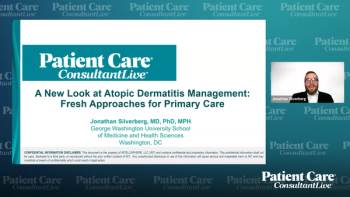Jonathan Silverberg, MD, PhD, MPH
Articles by Jonathan Silverberg, MD, PhD, MPH

A panelist discusses how simplifying treatment regimens, using nonsteroidal options, and fostering collaboration between primary care and dermatology can improve patient adherence and outcomes while emphasizing the importance of careful consideration when transitioning to systemic treatments or biologics due to safety concerns and patient needs.

A panelist discusses how the ADORING trial for tapinarof demonstrated good efficacy and safety, but emphasizes that treatment choices for atopic dermatitis depend on patient needs, preferences, and the specific characteristics of their condition, with factors like speed of action, safety, and adherence playing key roles in decision-making.

A panelist discusses how the real-world use of crisaborole, roflumilast, and ruxolitinib for atopic dermatitis reveals differing tolerability and efficacy, with roflumilast standing out for its superior results and ease of use while ruxolitinib is limited by safety concerns for larger areas of the body.

The speaker discusses the challenges of treating patients with topical steroid withdrawal, emphasizing the need for careful steroid reintroduction and responsible use while also exploring newer nonsteroidal treatments for atopic dermatitis and the barriers to access due to high costs and limited comparative effectiveness data.

A panelist discusses how patients cycling through numerous topical treatments, often without success, signals the need for treatment escalation or specialist referral, while emphasizing the risks and proper use of topical corticosteroids and calcineurin inhibitors in managing chronic dermatological conditions.

A panelist discusses how structured assessment tools like the itch Numeric Rating Scale, combined with a flexible, patient-centered approach to topical therapies—including both traditional steroids and newer non-steroidal agents—can improve atopic dermatitis management in primary care by enhancing treatment tracking, patient education, and access to appropriate care.

A panelist discusses how diagnosing and assessing atopic dermatitis across diverse skin types in primary care requires visual familiarity, patient-reported outcomes like itch severity, and practical tools such as body surface area and Investigator’s Global Assessment, emphasizing that effective management depends on combining clinical observation with patient experience.

A panelist discusses how recognizing the diverse presentations and patient demographics of atopic dermatitis—especially adult-onset cases and common mimics like scabies—is essential for accurate diagnosis and management in primary care, with an emphasis on clinical assessment over biopsy and the importance of cultural competence in dermatologic evaluation.

A panelist discusses how a fresh approach to atopic dermatitis management in primary care emphasizes early recognition, appropriate use of new topical therapies, and collaboration with dermatologists to address the disease’s diverse presentations and chronic course.


